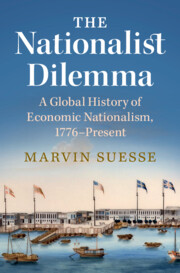Book contents
- The Nationalist Dilemma
- The Nationalist Dilemma
- Copyright page
- Dedication
- Contents
- 1 Introduction: Nationalists Think About the Economy
- 2 The American Community of the Common Man, 1776–1860
- 3 The Birth of the National Economy in Europe, 1789–1860
- 4 The Globalisation of the Nation, 1861–1913
- 5 The Nationalist as Saviour, 1914–1945
- 6 Policy in a World of Nation-States, 1946–1978
- 7 The Incomplete Building of a Global Economy, 1979–2001
- 8 Populist Discontents, 2002–2021
- 9 Conclusion and Outlook: Explaining Economic Nationalism
- Notes
- Index
2 - The American Community of the Common Man, 1776–1860
Published online by Cambridge University Press: 25 April 2023
- The Nationalist Dilemma
- The Nationalist Dilemma
- Copyright page
- Dedication
- Contents
- 1 Introduction: Nationalists Think About the Economy
- 2 The American Community of the Common Man, 1776–1860
- 3 The Birth of the National Economy in Europe, 1789–1860
- 4 The Globalisation of the Nation, 1861–1913
- 5 The Nationalist as Saviour, 1914–1945
- 6 Policy in a World of Nation-States, 1946–1978
- 7 The Incomplete Building of a Global Economy, 1979–2001
- 8 Populist Discontents, 2002–2021
- 9 Conclusion and Outlook: Explaining Economic Nationalism
- Notes
- Index
Summary
The United States was one of the world’s first modern nations and one of the first to break free from colonial rule. It therefore stands at the beginning of the history of economic nationalism. This chapter analyses how nationalist thinking on the economy evolved in the USA from the Revolution to the Civil War. During this era, nationalists shifted from an outward-focused system aiming for economic development to an inward-focussed system based on protection. Developmental ideas were first championed by Alexander Hamilton, but his elitist conception of economic policy did not sit easily with the democratising ethos of the new nation. Economic nationalism became a mass movement as intellectuals like Daniel Raymond, politicians such as Henry Clay and activists in the mould of Mathew Carey jostled over questions of trade, manufacturing and banking. Instead of Hamilton’s close relationship between government and capitalists, the new movement put the everyday American producer at the centre. As it did so, isolationist ideas came to dominate. The intellectual capstone of this strand was provided by Henry Carey, whose influence would entrench a distinctly protectionist ‘American System’.
Keywords
- Type
- Chapter
- Information
- The Nationalist DilemmaA Global History of Economic Nationalism, 1776–Present, pp. 12 - 43Publisher: Cambridge University PressPrint publication year: 2023



